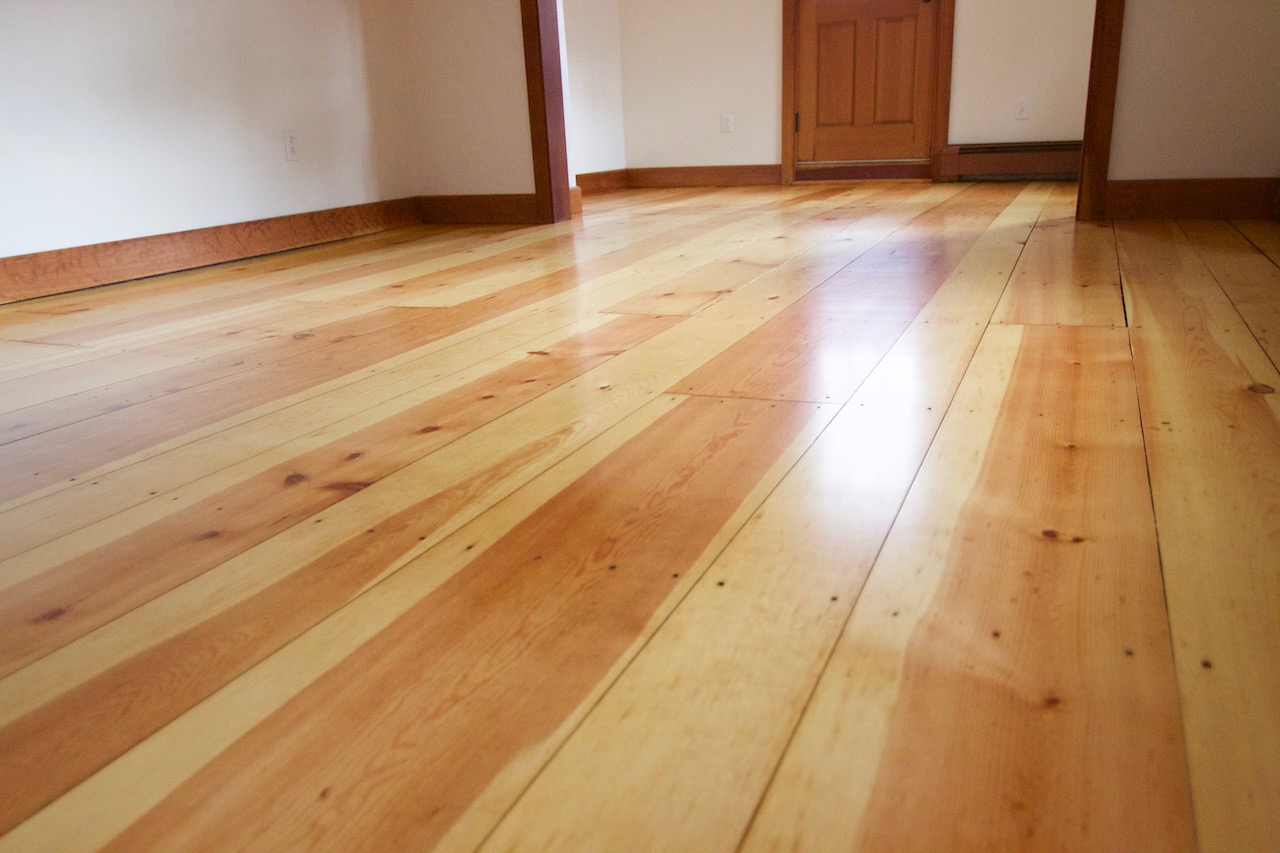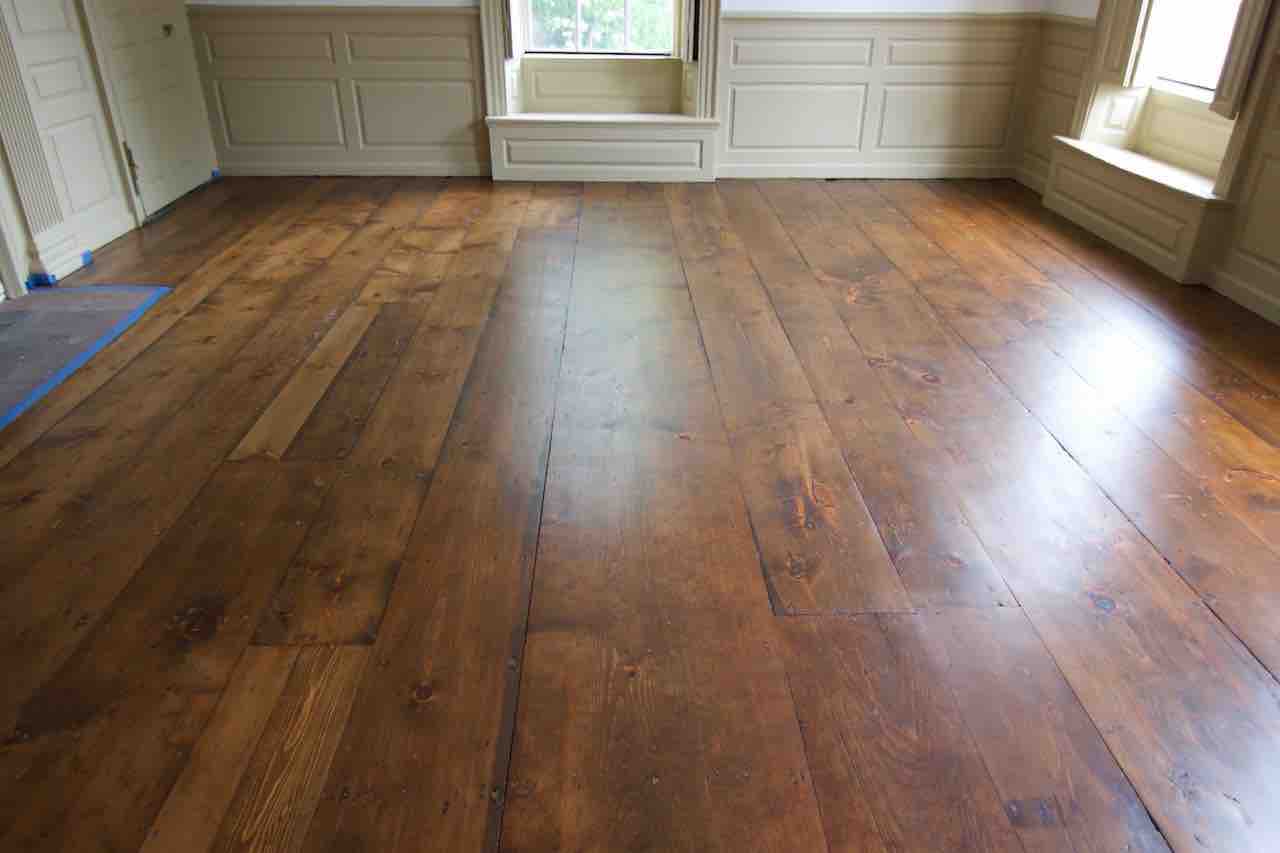Wood floor finishes
Wood floor finishes have changed and improved over the years. Research and science has helped improved the product that we use today. Making the wood floor finish better, easier to use and safer for our health and environment. With all the changes, the basic ingredients are the same. It all contains a solvent, dryer, leveling and matting agent. Some products may include de-foamers, catalyst, hardener and viscosity modifiers. Read along, to learn the general knowledge and how to use these different types of wood floor finishes available on the market.
Wood floor finishes : Sealers - types of base coats
- Oil-modified sealers: These are similar to finish topcoats, but with less solids and more solvents. The additional solvents helps the sealer to dry faster. It is combustible, meaning it can burn, has a moderate odor and dries between 2-6 hours. You must abrade this type of sealer prior to applying a topcoat to avoid adhesion issues. Generally, only one coat is allowed. Some of these sealers maybe illegal in your area, due to its VOC level. Check with the manufacturer for their application guidelines.
- Water base sealers: Its primary functions is to prevent tannin pull, panelization, side-bonding along with assisting in film building for water base topcoat wood floor finishes. There are three types of water base sealers: acrylic, urethane and acrylic/urethane blend. It has a low odor, fast drying time, usually 1-4 hours and is non-combustible. It does not need to be abraded under 48 hours, unless to remove dust and debris. The best application method is using a T-bar with a snow plow method with finger-tip pressure. Urethane water base sealers can be applied in multiple coats for a higher film build.
- Shellac: Is an alcohol base sealer, that has many benefits. Avoid using natural shellac, it contains wax and is not recommended under topcoats. It can cause adhesion issues. Instead use de-waxed shellac, which is a universal sealer. You can use de-waxed shellac over aniline dye and then apply a water base wood floor finish to prevent the aniline dye from moving around. Apply a thin coat and do not abrade the shellac, when top coating. The dry time is usually one hour, depending on the job site conditions. You can also, tint shellac and use it as a toner coat. Check with the manufacturer for application and abrading guidelines.
- Stains: Some stains are considered sealers. The benefits of multiple products in one. It eliminates the step for applying a sealer coat. You can apply a top coat directly on top. These types can require an abrasion prior to top coating. Check with the manufacturer for their application guidelines.
Film Forming Top coats
 Oil base polyurethane
Oil base polyurethane- Oil-Modified Urethanes: A yellow film forming wood floor finish with easy application, self-leveling and durability that can be applied on residential and commercial wood flooring. It has a moderate odor, ambering color and long dry times. It can be applied with a lambs wool, T-bar, brush, pad or roller. Intercoat abrasion is required in-between coats to prevent adhesion failure. Dry time is between 8-24 hours. Oil-modified urethanes will alter the final appearance of a stain finish. Colors should be sampled with finish. Cure time is between 14-30 days, depending on the manufacturer.
- Water Based Urethanes: A clear film forming hardwood floor finish that is easy to apply, exceptionally durable and self-leveling that can be used on residential and commercial wood flooring. These are either acrylic or emulsified urethanes carried by water. It is available as a one or two component finish. One component water base polyurethane floor finishes have a long pot life. Which helps reduce waste. With two components, once mixed you have a limited pot life, increasing waste. These wood floor finish can be applied with a pad, T-bar or roller. It is non-flammable and has a fast drying time, keeping a wet edge is very important to help avoid lap marks and brush marks. Water base urethanes do not require abrasion under 48 hours, unless dust and debris needs to be removed. Depending on the manufacturer, the cure time can be between 3-14 days.
- Moisture Cured Urethanes: A clear film forming wood finish with extreme durability and chemical resistant solvent based urethane. This finish cures with humidity. The higher the humidity, the faster. Making it a challenging finish to apply in high humidity conditions. Dry time can be as short as 30 minutes, with a full cure within 7 days. It has a very strong odor and is flammable. All open flames should be turned off prior to application. Intercoat abrasion is required for adhesion. Abrading can be challenging with its durability level. Two to three coats is required. Moisture cure urethane maybe illegal in your area with VOC's between 500-700. There are low 350 VOC moisture cure finish available.
- Tung Oils: A clear film forming wood finish that seals and finishes. It can darken over time. Some are hybrids and synthetic blends. It is considered combustible and has a strong odor with a long curing time up to 90 days. Drying time can be between 6-48 hours depending on the job site conditions. Best application method is with a lambs wool and brush. Multiple coats are usually needed for sufficient coverage. Intercoat abrasion is not required for adhesion, unless dust and debris needs removal. Check with the manufacturer for application guidelines.
- Conversion Varnish or Swedish/Acid Cure Finish: A two part solvent based clear film forming finish with excellent durability and chemical resistant. Similar to a moisture cure, but it does not dry with humidity. It requires a catalyst to harden and cure, where the catalyst contains acid. It also, requires air movement to assist in drying. Any trapped vapor will slow the drying process. The cure time can take up to 90 days. A heavy handle T-bar is best for applying conversion varnishes. Two to three coats is required. Do not over abrade these finishes, scratch marks can show through and it can affect the adhesion.
- On-site UV Cured Finish: A clear water base wood floor finish with exceptional durability, self-leveling and is easy to apply with the benefits of an instant cure. When exposed to high intensity UV light, a cross linking reaction cures the finish instantly. It has a mild odor and the UV light can cause skin cancer if, unprotected. These finishes do not always need abrasion. Check with the manufacturer for application details and guidelines.
- Natural/Hard Wax Oils: Penetrates to a certain depth and fills the fibers of the wood, protecting it from within. "Some" penetrating oils can be top coated with finishes. The benefits of these finishes are easy spot repairs, can be stained and finished in one step and endless unique coloring option. Several colors can be layered for a Ceruse effect. This type of wood floor finish requires frequent maintenance coats to ensure proper protection to the hardwood floors and does not resist chemicals well. Generally one or two coats is required. Check with the manufacture for application guidelines.
Wood floor finishes : Stains and Colorants
 Stain pine floors with a two part water base finish
Stain pine floors with a two part water base finish- Oil Base Wood Stains: The most widely available and popular type of wood stain. It is easy to apply and DIY friendly with a long open time. It can be applied with a rag, applicator or buffer. All excess stains should be removed and cleaned off immediately. Clean up is with mineral spirit. The down side is not all oil wood stain is compatible with a finish. Check with your manufacturer for compatibility. For the best compatibility for adherence, use products from the same manufacture.
- Water based Stains: Are similar to oil base stains, but should be treated differently. It has a very, fast drying time. It should be worked in small areas, applied with a synthetic applicator and wiped up immediately. To avoid lap marks, taping off sections will help. Multiple applications will result in a darker color.
- Aniline Dye stain: Allows for deeper and easier pigment penetration. Resulting in rich vibrant colors. It can be mixed in alcohol, water or solvent base finishes. Best use for tight grain, sappy wood like maple. Some aniline dyes tend to fade. Layering it with an oil stain will give it a rich looking result. It can be top coated with hard wax oils for endless color options and unique Ceruse effect. Use de-waxed shellac as a universal sealer to apply a water base wood floor finish on top. Best application is to use a garden sprayer for application and equalize with a WhichWiesel tool. Warning the more passes the darker the color. All painted surfaces should be masked off.
- Reactive Stains: Reacts with the tannins in a wood creating a unique stain effect. Reactive stains are generally available in smoke (brown) and fume (gray). Some are available with dyes that create custom colors. This type of stain can be top coated with penetrating/hard wax oil finishes, for Ceruse effect. Cons with this stain, liquid can cause movement in color, even after sealed with a top coat.
- Wood Bleach: There are three types of bleaches. 2 part bleach, oxalic acid and laundry bleach. Two part bleach is generally used to lighten floors, prior to applying stain. Oxalic acid is used to remove water and rust stains. Laundry bleach is used to remove dyes.
- Paint: Last on the list is paint. Paint is not commonly used, because the final result is usually opaque. But when mixed with a stain, it looks and applies like a stain. It allows the wood grains to show through and provides creative custom colors. Floor paint is widely used in sports floors: professional, college and high schools gym floors. It is compatible with sealers and polyurethanes.
There are endless options for wood floor finishes. Choose the one that best suits your lifestyle and meets your expectations. For best results, always follow NWFA and manufacture's guidelines for floor preparation and application.
Choose an ideal company
You have done all the research and now have the knowledge. Don't choose the wrong flooring company.
Why work with average, when you can work with an ideal hardwood flooring company? Avoid opting for sub-par products, poor workmanship, the lack of industry knowledge and training for the sake of something new.
With G & S Floors, you will experience optimum personal service, with superlative, effective premium quality workmanship in the industry and high quality products. Homes are one of the biggest and most important investments and should be cared by an ideal company.
We've been in business over 19 years. We are a NWFA flooring contractor and follow industry standards and best practice for hardwood flooring installation, sand and finishing. We have access to training and ongoing professional development. We have a well trained staff and we never stop learning. We have a powerful network of talented professionals, distributors, manufactures and experts.
Invest in "Quality" for better service and hardwood flooring that can last a lifetime or centuries!

